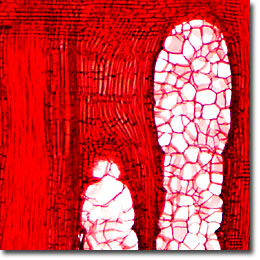The Black Locust
The Black Locust (Robinia pseudoacacia) is a hardwood tree with a growth range extending from Pennsylvania southward to Alabama and westward to southern Illinois. This beautiful tree is planted widely around the world as an ornamental tree because of its fragrant, attractive flowers and beautiful foliage. The sapwood is yellowish and narrow, while the heartwood ranges from green to greenish yellow, dark yellow, or golden brown.

Cross Section

Radial Section

Tangential Section
The tree grows very rapidly (sometimes becoming a pest) to heights of over 80 feet, often with a bifurcated trunk and having a scaly, furrowed bark that becomes gray-brown upon maturation. Propagation occurs by seed or radical suckers. Black locust wood is widely used for fence posts, mine timbers, poles, railroad ties, stakes, and insulator pins (formerly the principal product made from black locust wood). The wood is well adapted for this purpose (insulator pins) because of its strength, durability, and moderate shrinkage and swelling, which tend to prevent the pins from loosening in the cross arms.
Microscopic examination of iron-alum hematoxylin and safranin stained thin sections (see the digital images presented above) reveals relative few, but large vessels with simple perforation plates. Spiral thickening is present in the small vessels in late wood, which are occluded with tyloses. Vestured inter-vessel pits range from 5 to 12 micrometers in diameter, and are orbicular to oval or angular (through crowding) in shape. Parenchyma is abundant but marginal, and the unstoried rays range from 3 to 5 seriate.